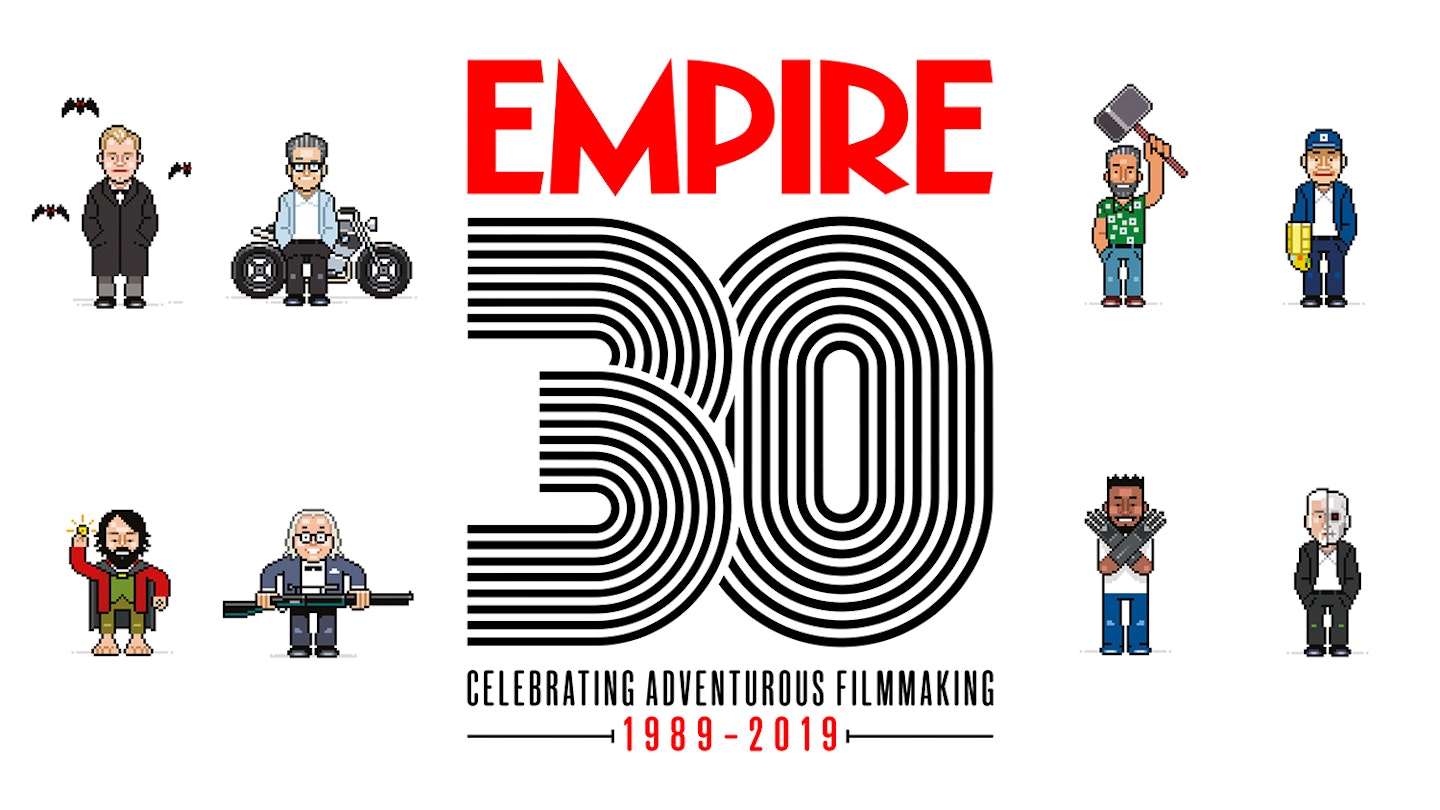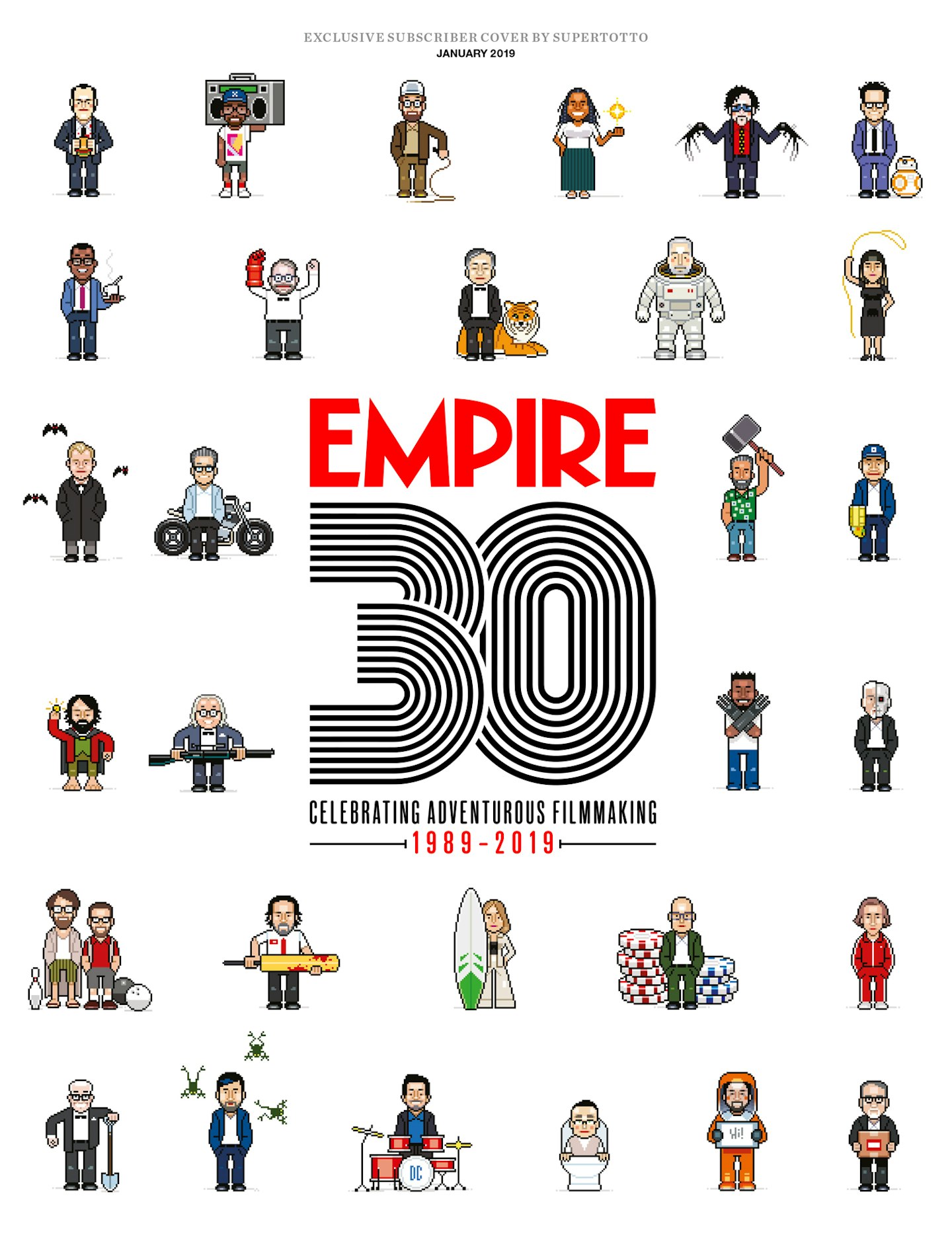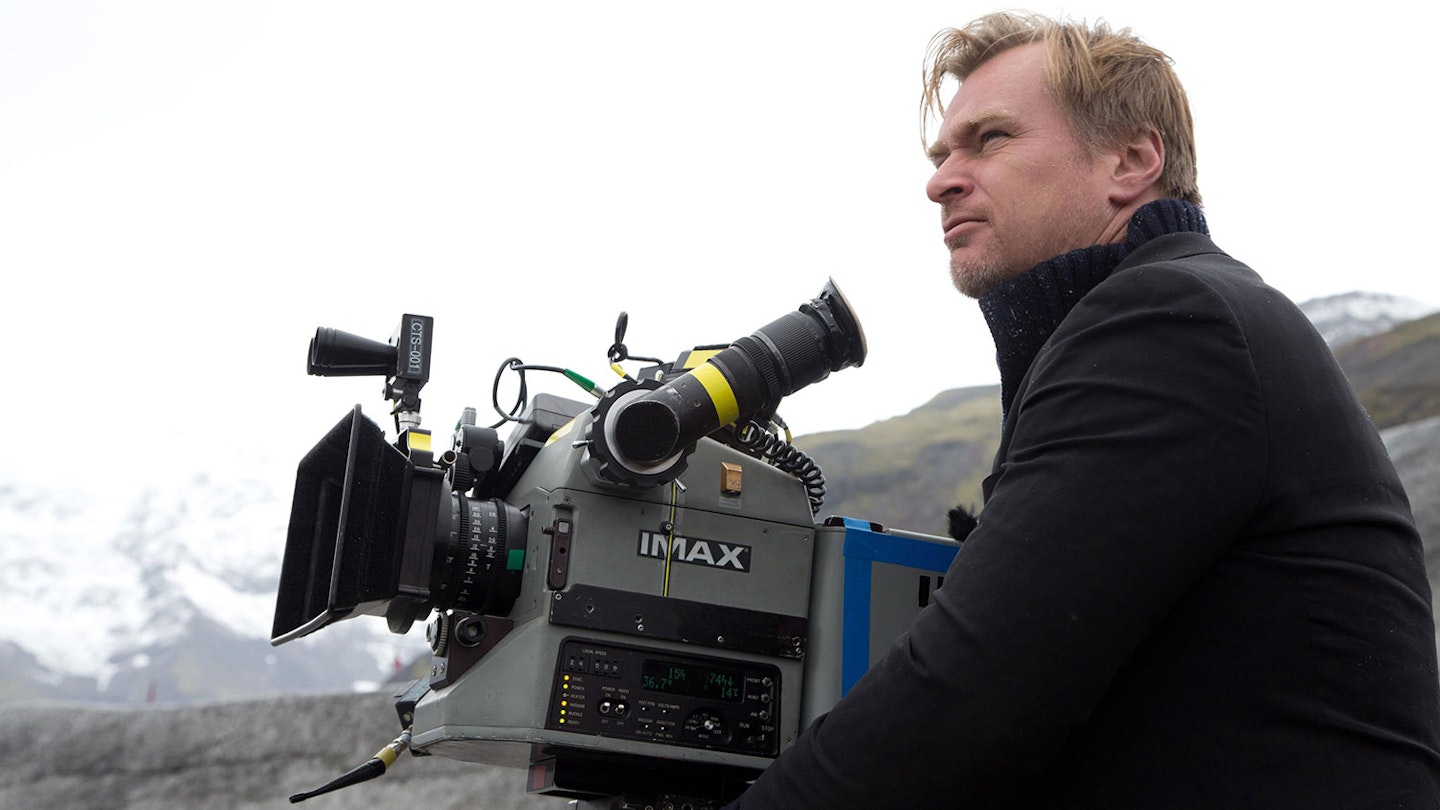As part of our Empire 30 celebrations, Dan Jolin recalls his experiences visiting the sets of Christopher Nolan and coming face-to-face with the man himself. Originally published in the April 2019 issue of Empire.

Late in the evening of 19 November 2009, I took a long drive into the mountains of Alberta. As the sun slipped behind snow-smothered peaks and the winding road darkened, I had no idea exactly where I was going or how long it would take to get there. Neither did my cabbie, who in the end pocketed a $200 fare when it turned out the ski resort I needed to get to was 85 miles away from Calgary airport. It wasn’t quite the middle of nowhere, but it was winter in Canada and felt about as far as you can get from the rather more temperate and accessible studio sound stages I was used to frequenting for Empire set visits. But, as I tugged my luggage out of the bemused cabbie’s trunk and yomped through the crusty snow to the resort’s reception, I wasn’t surprised. This was a Christopher Nolan movie. And if there’s one thing I’ve learned from watching Christopher Nolan make movies, it’s that he never does anything the easy way.
Not that Nolan likes things to be difficult. He just likes things to be right. While the movie industry, specifically the business of blockbusters, has embraced and evolved digital technology to achieve epic visual flourishes once thought impossible, Nolan has steadfastly, uncompromisingly followed his own path. He is well known for holding onto traditional techniques, shooting on high-resolution film, often on location — whatever the weather — and employing in-camera effects whenever possible. “Whatever we do, it has to be real,” I heard him tell production designer Nathan Crowley on the set of Interstellar. They were discussing, of all things, a handrail which needed to be fixed to a low rooftop wall for a scene they were shooting in downtown Los Angeles the next day. But that’s Nolan all over. Everything has to feel real — a “tactile, exciting reality”, to use his own words — whether it’s a guy dressed in bat-armour, a punch-up in a tumbling dreamscape, a spaceship entering a wormhole, or a metal rail on a rooftop wall.
This has always held true, and couldn’t have been more obvious than on my first-ever Nolan set experience, for The Dark Knight, in August 2007. It wasn’t the mountains of Canada — to which we’ll return later — but he had managed to cordon off the usually bustling LaSalle Street in Chicago’s financial district on a Friday, to the annoyance of some locals. Having realised Gotham mostly through elaborate model work for Batman Begins, he was determined to move the caped vigilante onto more relatable, grittier turf, and felt Chicago, where he spent part of his childhood, was the ideal match.

That day he was mounting the funeral of Commissioner Loeb and the panicking-crowd chaos that follows an attack by the Joker (Heath Ledger). It was a complex scene which required hundreds of extras and booming ballistics, but despite this being his biggest, most ambitious movie yet, its orchestrator never once broke a sweat. “You get a lot more used to it,” he shrugged when I asked him about the challenges of stepping up to this scale in a live location environment. There’s never any drama with Nolan. No hyperbole. Even when things go wrong.
And I have seen something go wrong on a Nolan set. It was my last morning in Kananaskis, Alberta for Inception. I’d spent the past two days on a mountainside, protected from the sub-zero, high-altitude conditions by multi-layered arctic-survival gear that puffed me out to the dimensions of a Teletubby. When I wasn’t sheltering from the elements in a grey, slope-hugging fortress built for the production, or watching Nolan’s crew chuck snowballs at each other between takes, I mostly spent my time watching Tom Hardy, the last actor on call, take part in a gun-toting ski chase right out of On Her Majesty’s Secret Service. That final morning, I was supposed to be relaxing at the hotel before heading to the airport in the afternoon, but Nolan invited me back to the set for the very last day of principal photography, which he’d decided to conclude with a literal bang.
Beneath the prefab snow fortress, special-effects supervisor Chris Corbould had rigged 40 sticks of dynamite and a dozen 20-gallon barrels of gasoline. (Corbould took me down there to show me them. Nothing makes you feel more mortal than standing in a room filled with explosives.) The idea was the building would explode and tumble down the defunct ski-slope on which it had been constructed. It was a one-take deal. As charges and wires were checked and five cameras set up, with a sixth in a circling helicopter, I joined the crew, gathered at a safe distance near the slope’s base, their breath puffing into the crisp air in anticipation of a big end-of-show fireworks display.

But when the moment finally came, just past lunchtime, we didn’t quite get the show we were hoping for. Thanks to a rear set of explosives not igniting as planned, the explosion only caused the building to fall backwards in a kind of sad slump, rather than blast out onto the slope. There was some disappointment, a few jokes (“How long to reset?” someone asked), but Nolan himself was entirely unbothered.
“It did not go quite as planned,” he told me in the Inception edit suite at his Los Angeles home a few months later, “but we’re still using the shot.” The initial explosion is right there on screen. The rest wasn’t even fixed in post. Nolan had planned “an enormous miniature explosion” anyway, so he just used that footage to complete the sequence. Simple.
—
I’ve been on six Nolan sets during the past 12 years, for four of his films, and I’ve never once seen him flustered. The only time I’ve seen him lose his calm, tea-flask-swigging composure was for a brief moment on the Dark Knight Rises shoot in New York City, in November 2011.
Once again he was on the streets of a real city, and once again he was choreographing a big crowd, 1,200 strong now, as Gotham’s finest duked it out in a snowstorm (fake snow this time) with the League Of Shadows’ troops on Wall Street. In the midst of it all, a whopping IMAX Steadicam whirling around them, were Christian Bale and Tom Hardy trading blows in full superhero and villain costume. Nolan stood nearby, watching intently, when Bale suddenly stumbled backwards in his direction. It’s the fastest I’ve ever seen Nolan move, dodging out of Batman’s way. But still, he didn’t even spill his tea.

To this day, Nolan has never gone overbudget on a movie, or run into extra time. He plans meticulously, and deals with any setbacks calmly. He also has a set of highly efficient, regular collaborators on whom he knows he can rely. Unflappable first-assistant director Nilo Otero, for example, who I’ve never seen without a toothpick poking out of the corner of his mouth. Editor Lee Smith, who’s cut every Nolan movie since Batman Begins. Nathan Crowley, who’s designed seven Nolan pictures. Paul Franklin, who oversaw visual effects on five. Jonathan Nolan, his younger brother and regular co-writer. And, of course, Emma Thomas, his producing partner and wife, who’s worked with him ever since their debut, shot-at-weekends DIY feature Following, and is always the first person to meet me, with a beaming smile, when I arrive on Nolan’s sets.
Despite what you might guess from the plots of Inception and Interstellar, Nolan’s family are never far away from him. I’ve seen his four kids on set, for instance, at Heinz Field Stadium in Pittsburgh, where they walked out on the pitch with Thomas — in front of 11,000 extras (I guess they must be used to big crowds on his films) — while Nolan was shooting Bane’s big-bomb reveal. And the four films I observed him shoot had production titles named after them: ‘Rory’s First Kiss’ (The Dark Knight), ‘Oliver’s Arrow’ (Inception), ‘Magnus Rex’ (The Dark Knight Rises) and ‘Flora’s Letter’ (Interstellar). It gives a strong sense that every movie is personal to him, no matter how big they get.
And they just keep getting bigger. The scale of The Dark Knight Rises was like nothing I’d ever seen, before or since. To fill half a stadium with 11,000 people, rather than seat a few hundred and then digitally replicate them, is pure Nolan. The spaceship sets for Interstellar, around which Thomas gave me a personal tour, were mindblowing — not least because I didn’t see a single green screen. I’m proud to say I’ve sat in the cockpits of both the Endurance and the Ranger, and waggled the very same joystick Matthew McConaughey grasped as intrepid NASA pilot Cooper. It was a true thrill, and I obviously hadn’t even seen the movie yet. Like the man said: tactile, exciting reality.

Nolan took it even further on Dunkirk. His commitment to realism extended so far as to shoot on the same beach where the real evacuation occurred, with real fighter planes and ships (some of which were used in the real Operation Dynamo in 1940). A decision that meant working under some gruelling conditions, thanks to the French weather turning unseasonably nasty during the early summer of 2016, and the rapidly turning tide.
I didn’t make it to that set — it was a very tough show, I’m not sure they needed me getting in the way — but I did walk the length of that beach with Thomas during a press event in March 2017. As we talked, the wind whipped at us constantly, salt and sand blasting our faces. I could only imagine what it was like being there with 1,300 extras in period costume, trying to shoot it all with heavy, fragile IMAX cameras. “The sand was a nightmare,” confirmed Thomas, “and being around saltwater was a nightmare for the camera crew.” Yet once again Nolan coolly triumphed, earning his first Oscar nomination for directing, and delivering on his promise to truly immerse audiences in an intense, true-life (or death) race against time.
—
While the movies have grown bigger and more ambitious, Nolan himself remains unchanged. He learns new things on every film, he’s told me, but the director I talked to about Dunkirk in 2017 was no more confident and no less passionate than the filmmaker of The Prestige in 2006, my first ever encounter with Nolan (during which he told me off for having read the book before seeing his adaptation). This image of immutability is only enforced by his sartorial consistency — he always wears a suit and waistcoat with open-necked, sky-blue shirt — and his on-set habits. I’ve never once seen him sit down on a movie set. He’s never set up a video village, where directors usually scan playback of scenes just shot in relative comfort. The only monitor I’ve seen him use is a small, handheld one, which means he can always stay as close to the action as possible — even if it does mean almost getting trodden on by Batman. I’ve never heard him raise his voice, and I’ve rarely seen him without his tea flask.
I have, however, seen him smile, and laugh, and joke. Nolan has been described as humourless and aloof (“He’s a cold guy who makes cold films,” one Hollywood producer once told the LA Times), but for all his focus and unerring commitment, it is clear that making movies brings him joy.

Never more so than when I arrived on the Sony Pictures lot in November 2013, to find him remote-operating a 12-ton spaceship on a gimbal, with a huge grin on his face. He was, as Thomas put it, “enjoying things far too much”. It was good to see. Nolan takes film seriously, and gives serious answers to questions about filmmaking. But he’ll also just as readily say he’s done something, “just because it’s fun”.
I’ll be surprised if he ever tackles anything like a romcom, and I can still only guess what his big 2020 “event film” is going to be (I certainly wouldn’t bet on him returning to his abandoned 2002 Howard Hughes project). But one reason his movies do so well, aside from their impressively distinct, reality-based visual texture, is because they are downright entertaining. Nolan has an instinct for what people enjoy watching, especially if it’s something they don’t know they’ll enjoy. And that stems from his own sheer enjoyment of filmmaking. Every project he embarks on is an adventure, whether it’s to the beaches of Northern France, the streets of Chicago or the mountains of Canada. Where the next adventure will take him remains a tantalising mystery. But one thing’s for sure: it won’t involve doing anything the easy way.

